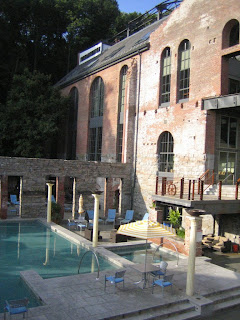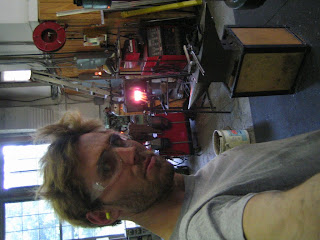The Treadle hammer. Awesome for precision hot-cutting, punching, or for when you need a very accurate and controlled application of hammering force. Basically, a very strong third arm. I'm building one ASAP.

The foot pedal.

The strike plate, a 1" piece of mild steel. I suppose you could use Aluminum as well.

Samuel Yellin original drawing. I revere this man. He was a master, and his empire of metal is worth looking in to.

His initials.

The spring-swage rack. Amazing amount of dies here.

Close up of the 7/8" spring-swage. This goes under the powerhammer.

Close-up of the 7/8" spring-swage.

Here I am, powerhammering the pipe from 1" to 7/8".

How does one powerhammer pipe without it collapsing, you ask? Fill the pipe with sand, weld the ends shut, forge to desired shape, then cut off the ends and dump out the sand.

Here's the beginning stages of me forging an escutcheon (the little decorative thingy that connects a chandelier or lighting fixture to the cieling). I start by laying out a piece of 1/4" metal on a big swage block, over the 3" bowl depression.

Apply heat with a torch.

Start hammering with crowned end of planishing hammer. Start in middle of bowl and work out from there in concentric circles The learning curve gets steepens from here. You have to be able to see, as Chris says, "line and shadow".

More hammering and sighting.

Here's the product, semi-finished. I still have to hot-cut the outline around the bowl and all that good stuff.

A hot-cutting chisel under the Treadle Hammer.

A number of cool dies for the hydraulic press. We use these to decorate, texture, or otherwise shape the things like drawer-pulls or bolt-heads.




The local climbing gym. I climbed here a few times, but I barely had any energy to pull on holds.

I'm going to miss Baltimore alleyways.

Here's some shots of a chandelier we made. Fitting the metal arms to the alabaster bowl was extremely hard and time-consuming.































